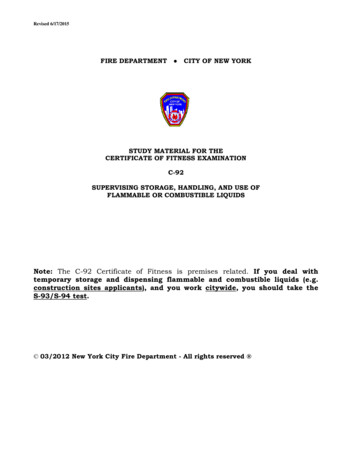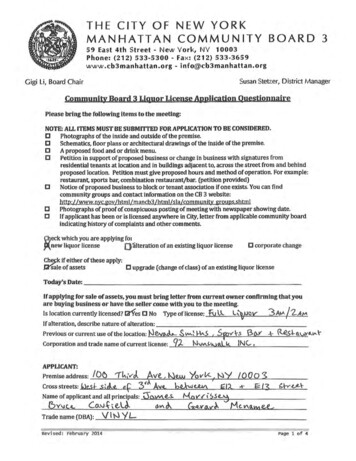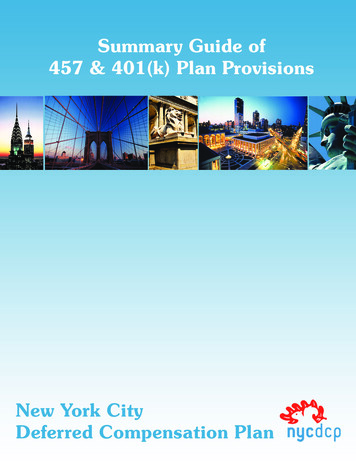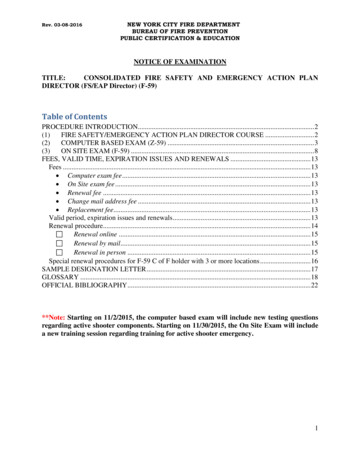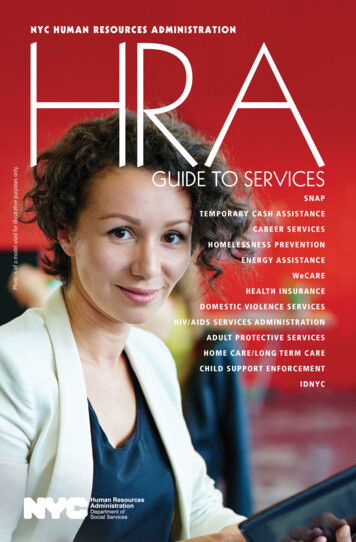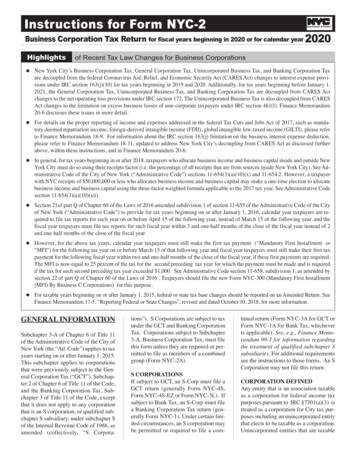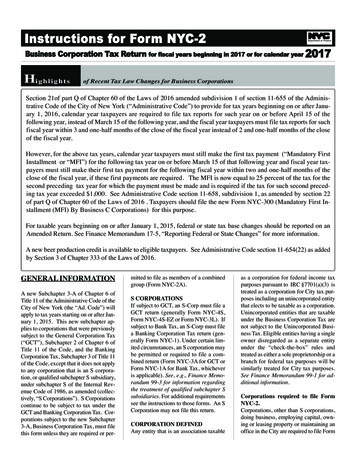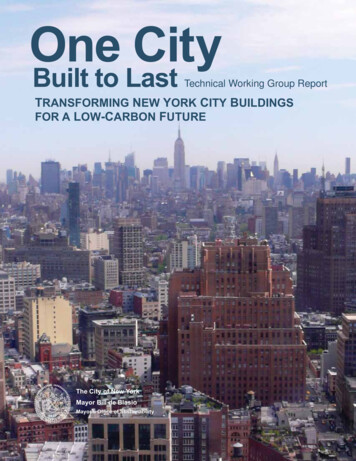
Transcription
One CityBuilt to LastTechnical Working Group ReportTRANSFORMING NEW YORK CITY BUILDINGSFOR A LOW-CARBON FUTUREThe City of New YorkMayor Bill de BlasioMayor’s Office of Sustainability
One CityBuilt to LastTechnical Working Group ReportTRANSFORMING NEW YORK CITY BUILDINGSFOR A LOW-CARBON FUTUREThe City of New YorkMayor Bill de BlasioMayor’s Office of Sustainability2nd Edition
TABLE OF CONTENTSEXECUTIVE SUMMARY1BackgroundMajor Findings and Next StepsSummary of Research and Analysis1: BACKGROUND & BUILDING SECTOR ANALYSIS17IntroductionAnalysis of New York City Buildings Today and In 20502: REDUCING ENERGY USE IN EXISTING BUILDINGS33Characteristics of Existing BuildingsEfficiency MeasuresOn-Site Distributed Generation MeasuresComprehensive Building System Upgrades3: DESIGNING FOR WHOLE BUILDING ENERGY PERFORMANCE101Impact of Future Buildings4: GHG REDUCTIONS FROM ALL BUILDINGS117Realizing the Full Potential of GHG Reductions in BuildingsTenant Energy Use and Other “Unregulated” LoadsBuilding Workforce CapacityBringing Down the Costs of Energy Efficiency Improvements5: CONCLUSION1356. APPENDIX1417. END NOTES147Acronyms and Abbreviations
Letter fromthe Mayor
Friends,Climate change is an existential threat to humanity, and New York City is on the frontlines. That’s why we are committed to reduce our greenhouse gas emissions 80 percentby 2050. The comprehensive report of the Buildings Technical Working Group that werelease today marks a milestone in our fight against climate change.In September 2014, when we announced our 80 x 50 target in One City: Built toLast, we committed to launch a task force and assess how to place our buildings on apathway to achieve this vital goal. Following this commitment, the Buildings TechnicalWorking Group engaged in a collaborative, data-driven effort that was unprecedentedin its level of ambition and the depth of research on actual buildings and how they useenergy. More than 50 leaders in real estate, architecture, engineering, construction,finance, affordable housing, and environmental justice, in addition to countless Citystaff and volunteers, met for more than a year to deliver the recommendations inthis report. With their assistance, the City also conducted the most comprehensiveanalysis of energy use in New York City’s buildings to date. The data showed us thebest opportunities for buildings to reduce GHG emissions and put New York City on apathway to 80x50. This report and its recommendations were created by New Yorkers,for New Yorkers.In this report you will be able to explore the way energy is used in New York Citybuildings, the most common types of buildings citywide, and the most effectivestrategies to reduce energy use and GHG emissions in both new and existing buildings.In addition to these findings, we have outlined a series of new actions that the City willtake, including adopting new codes and measures for energy performance, requiringcomprehensive upgrades to heating distribution systems, and integrating deep energyretrofits into capital planning.The initiatives in this report will save building owners on energy costs, cut greenhousegas emissions, and improve our air quality. They will create jobs, and improve thecomfort and quality of the spaces where New Yorkers live, work, and play. They are aninvestment in our future. Together, these initiatives will help New York City rise to theglobal challenge of averting the most disastrous impacts of climate change and protectthe planet for future generations to come.Mayor Bill de Blasio
AcknowledgementsThis valuable work was conducted by more than 50 leaders from New York City’sworld-class real estate, engineering, architecture, labor union, affordable housing,academic, government, and environmental advocacy sectors who were appointedto serve on the Buildings Technical Working Group (TWG). This unprecedentedlevel of effort would not have been possible without the following individuals andorganizations.Director Nilda MesaNew York City Mayor’s Office of SustainabilityCommissioner Vicki BeenDepartment of Housing Preservation and DevelopmentCommissioner Rick ChandlerDepartment of BuildingsCommissioner Lisette CamiloDepartment of Citywide Administrative ServicesPresident Lorraine GrilloSchool Construction AuthorityChair Shola OlatoyeNew York City Housing AuthorityCommissioner Feniosky Peña-MoraDepartment of Design and ConstructionCommissioner Carl WeisbrodDepartment of City PlanningThe incredibly hardworking staffs at HDR, Inc. and the Departmentof Buildings, Department of City Planning, Department of CitywideAdministrative Services, Department of Design and Construction,Department of Housing Preservation and Development, LandmarksPreservation Commission, New York City Housing Authority, Officeof Sustainability, Office of Management and Budget, and the SchoolConstruction Authority; and a special thanks to:Ellen Abramowitz, Mina Agarabi, Brian Baldor, Denis Belic, ChrisBenedict, Josh Berengut, Jonathan Beuttler, Jennifer Bienemann,Michael Blasnik, Jason Block, Gina Bocra, Tara Boirard, Eric Boorstyn,Daniel Bower, Jeff Brodsky, Ryan Cassidy, Margaret Castillo,Christopher Cayten, Nicole Ceci, Kimberly Darga, Jennifer Davis,Minelly De Coo, Emily Dean, Donna DeCostanzo, Michael DeLoach,Jonathan Dickinson, David Dimitri, Dan Donnelly, Richard Eiden,Thomas Eisele, Luke Falk, Gary Fescine, Yetsuh Frank, Amy Furman,Jocelyn Gan, Chris Garvin, John Gearrity, Diana Glanternik, ErickGregory, Elizabeth Hanson, Chris Haun, Cory Scott Herrala,Melanie Ho, Emily Hoffman, Michael Ingui, Bomee Jung, Eric Kane,Larry Katz, Nidhi Khanna, Jennifer Klein, Ben Kornfield, SergueiKouznetsov, Talia Kula, Emily Kurtz, Jonah Lee, John Lee, StacyLee, Luke Leung, Ken Levenson, Alexandra Levine, Aaron Lewis,Gwendolyn Litvak, Patrick Love, Ross MacWhinney, Samuel Man,Michael Marrella, Richard Morales, Robert Muldoon, Jennifer Nagle,Robin Neri, Heather Nolen, Ozgem Ornektekin, Thomas Paino,Cathy Pasion, Francis Redhead, Dan Rieber, Jeff Rios, Luis Rios,Lindsay Robbins, Paul Rode, Paul Romano, George Roussey, KristineRyan, Arianna Sacks-Rosenberg, Grant Salmon, Pinky Samat, HollySavoia, Scott Short, Howard Slatkin, Laura Slutsky, Amy Spitalnick,Chris Starkey, Carter Strickland, Wilson Suarez, Amy Sugimori, LauraTajima, Jenna Tatum, Shanta Tucker, Dara Yaskil, and Mark Zimet
Roger AndersonDaniel AveryBuilding Owners and Managers AssociationRyan BaxterReal Estate Board of New YorkMichael BobkerCIUS Building Performance Lab, City College of New York, CUNYGene BonibergerRudin Management Co., Inc.Louis ColettiBuilding Trades Employers’ Association of New York CityMichael ColgroveNew York State Energy Research and Development AuthorityRebecca CraftConsolidated Edison, Inc.David DavenportUrban GreenfitAurelio Mark de YoannaNational GridChristopher DiamondNew York City Energy Efficiency CorporationNatasha DwyerThe New York City Environmental Justice AllianceWilmouth Elmes PEManhattanville Development Group/Columbia UniversityHéctor Figueroa32BJ Service Employees International UnionWendy FokNatural Resource Defense Council-Center for Market InnovationScott FrankAmerican Council of Engineering Companies of New YorkJonathan FlahertyTishman SpeyerNancy Aber GoshowAmerican Institute of Architects New YorkAlexandra HansonNew York State Association for Affordable HousingNicholas HoltSkidmore, Owings & Merrill, LLPCarl HumReal Estate Board of New YorkBrook JacksonPartnership for New York CityAaron Jones32BJ Service Employees International UnionVicki KuoConsolidated Edison, Inc.Dominique LempereurKW Engineering, Inc.Paimaan LodhiReal Estate Board of New YorkMurray Levi, AIA LEED APIFMA International Facility Managers AssociationTerri LudwigEnterprise Community PartnersTony MalkinEmpire State Realty TrustCharlie Marino (AKF Group)American Society of Heating, Refrigerating, & Air-Conditioning EngineersBobbi McGowanBuilding Owners and Managers AssociationJolie MilsteinNew York State Association for Affordable HousingJuan Camilo OsorioThe New York City Environmental Justice AllianceSteve PekofskyGlenwood Management Corp.Frank RicciRent Stabilization AssociationMary Ann RothmanCouncil of New York Cooperative and CondominiumsDana Robbins SchneiderJLL, Empire State Realty TrustCecil ScheibUrban Green CouncilLaurie SchoemannEnterprise Community PartnersPatrick SiconolfiCommunity Housing Improvement ProgramZach SternLocal 94 Operating EngineersRussell UngerUrban Green CouncilElizabeth VelezVelez OrganizationMichael NorthropRockefeller Brothers FundLee WassermanRockefeller Family FundDonald J. Winston PE FASHRAEIlana Judah (FXFOWLE)New York Building CongressJennifer WilcoxCity Council Speaker’s OfficeJosh KellermannALIGN: The Alliance for a Greater New YorkSteven WinterSteven Winter Associates, IncJudi KendeEnterprise Community PartnersRichard YanceyBuilding Energy ExchangeLaurie KerrUrban Green CouncilMarc ZuluagaSteven Winter Associates, Inc.Nico KienzlAtelier Ten
80X50
EXECUTIVE SUMMARYClimate change is an existential threat to New York City and humanity. As the climatechanges, New York City faces the prospect of more frequent and intense extremeweather events including storms, heavy downpours, heat waves, droughts, and highwinds. Chronic conditions such as rising sea levels, higher average temperatures, andincreased annual precipitation will exacerbate these extreme weather events and theirimpacts on the city’s residents.Cities play an important role in addressing global climate change and mitigating theserisks. More than half of the world’s inhabitants live in urban areas, where populationgrowth is expected to continue through the 21st century. Already, cities are responsiblefor more than 70 percent of global energy-related carbon dioxide emissions.1 InSeptember 2014, New York City Mayor Bill de Blasio committed to reduce New YorkCity’s greenhouse gas (GHG) emissions 80 percent below 2005 levels by 2050 (80 x50), joining other leading cities around the world in committing to the target the UnitedNations set for developed countries to avert the worst impacts of climate change.Since then, the Mayor has committed to additional targets, which include the “Under2 MOU,” a commitment among subnational governments to limit GHG emissions tounder two metric tons of carbon dioxide equivalent (tCO2e) per capita, and an interimtarget of a 40 percent GHG reduction by 2030 (40 x 30). Because the energy usedin New York City’s buildings accounts for nearly three-quarters of citywide GHGemissions, addressing building energy performance will be critical to meeting thesecommitments. This report presents the strategies that New York City will pursue tomeet its GHG reduction goals within the building 73%Fig. E1. Share of New York CityGreenhouse Gas Emissions bySectorSource: NYC Mayor’s OfficeNew York City’s GHG emissions come from the electricity and fuel used to heat,power, and cool our businesses, homes, and institutions, the vehicles that are used totransport us across, into, and out of the city, and the removal and disposal of our solidwaste. More than 80 percent of the energy consumed for these activities is generatedfrom the combustion of fossil fuels.2These actions have regional impact. Approximately 40 percent of New York State’sGHG emissions are generated in New York City, which is by far the state’s largesturban area. Because of our extensive transit system and low private vehicle use, theenergy used in buildings accounts for 73 percent of citywide GHG emissions, which iswell above the national average of 40 percent attributed to buildings.3To achieve our 80 x 50 commitment, citywide emissions from all sources will need tobe reduced by 44.5 million metric tons of carbon dioxide equivalent (MtCO2e) from a2005 baseline by 2050 – or more than the total annual GHG emissions produced by theentire state of Connecticut.41
55.6 MtCO2e2005BaselineWaste3.449.1 tricity14.180x50Goal11.1 MtCO2eBuildingsOther FuelsBuildingsOther Fuels20.721.8The City of New York’s (City’s) updated Inventory ofNew York City Greenhouse Gas Emissions in 2014 foundthat from 2005 to 2014, New York City reduced itsannual GHG emissions by 11.7 percent (6.5 MtCO2e),and reduced per capita emissions by 15.9 percent. NewYork City’s per capita emissions are now 5.8 MtCO2eper person, which is just over one-third of the Americanaverage of 17 MtCO2e per capita.5 In the same period,GHG emissions from the energy used in buildingsdecreased by 12.8 percent, or 5.9 MtCO2e, even as builtsquare footage increased by roughly six percent andeconomic output increased by 15.8 percent. However,the rate of these reductions has slowed in recent years,primarily due to the colder winters of 2013 and 2014that increased demand for heating fuel. While New YorkCity’s GHG reductions represent progress, the reductionsachieved to date will need to be accelerated to reach80 x 50.Buildings Technical Working Group ApproachFig. E2. 80 Percent GHG Emissions Reduction to 2050, in MillionMetric Tons of Carbon Dioxide Equivalent (MtCO2e)Source: Inventory of New York CityGreenhouse Gas Emissions in 2014Last year, Mayor Bill de Blasio convened more than 50leaders from New York City’s world-class real estate,engineering, architecture, labor, affordable housing, academic, and advocacy sectors toserve on the Buildings Technical Working Group (TWG). The TWG was tasked withidentifying the leading edge standards that should be developed for new constructionand substantial renovations and the systems-specific efficiency measures for existingbuildings that would be necessary to transform the city’s building stock to achieve deepcarbon reductions. At the time, the City expected that the best strategy to cut GHGemissions from buildings would be achieved through a combination of identifying thesemeasures and setting GHG
Cathy Pasion, Francis Redhead, Dan Rieber, Jeff Rios, Luis Rios, Lindsay Robbins, Paul Rode, Paul Romano, George Roussey, Kristine Ryan, Arianna Sacks-Rosenberg, Grant Salmon, Pinky Samat, Holly Savoia, Scott Short, Howard Slatkin, Laura Slutsky, Amy Spitalnick, Chris Starkey, Carter Strickland, Wilson Suarez, Amy Sugimori, Laura Tajima, Jenna Tatum, Shanta Tucker, Dara Yaskil, and Mark
